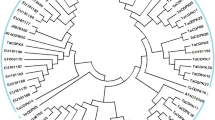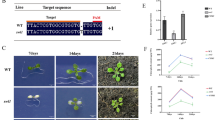Abstract
Previously, the growth of Arabidopsis hit1-1 (heat-intolerant) mutant was found to be inhibited by both heat and water stress (Wu et al. in J Plant Physiol 157:543–547, 2000). In order to determine the genetic mutation underlying the hit1-1 phenotype, map-based cloning of HIT1 gene was conducted. Transformation of the hit1-1 mutant with a HIT1 cDNA clone reverts the mutant to the heat tolerance phenotype, confirming the identity of HIT1. Sequence analysis revealed the HIT1 gene encodes a protein of 829 amino acid residues and is homologous to yeast (Saccharomyces cerevisiae) Vps53p protein. The yeast Vps53p protein has been shown to be a tethering factor that associates with Vps52p and Vps54p in a complex formation involved in the retrograde trafficking of vesicles to the late Golgi. An Arabidopsis homolog of yeast Vps52p has previously been identified and mutation of either the homolog or HIT1 by T-DNA insertion resulted in a male-specific transmission defect. The growth of yeast vps53Δ null mutant also shows reduced thermotolerance, and expression of HIT1 in this mutant can partially complement the defect, supporting the possibility of a conserved biological function for Vps53p and HIT1. Collectively, the hit1-1 is the first mutant in higher plant linking a homolog of the vesicle tethering factor to both heat and osmotic stress tolerance.





Similar content being viewed by others
Abbreviations
- SNARE:
-
Soluble N-ethylmaleimide-sensitive factor adaptor protein receptor
- SSLP:
-
Simple sequence length polymorphism
- CAPS:
-
Cleaved amplified polymorphic sequence
- SNP:
-
Single nucleotide polymorphism
- HSP:
-
Heat shock protein
- LEA:
-
Late embryogenesis abundant
- COR:
-
Cold regulated
- VPS:
-
Vesicular protein sorting
- RT-PCR:
-
Reverse transcription-polymerase chain reaction
References
Advani RJ, Yang B, Prekeris R, Lee KC, Klumperman J, Scheller RH (1999) VAMP-7 mediates vesicular transport from endosomes to lysosomes. J Cell Biol 146:765–766
Ashraf M, Saeed MM, Qureshi MJ (1994) Tolerance to high temperature in cotton at initial growth stages. Environ Exp Bot 34:275–283
Blatt MR, Leyman B, Geelen D (1999) Molecular events of vesicle trafficking and control by SNARE proteins in plants. New Phytol 144:389–418
Burke JJ, Upchurch DR (1989) Leaf temperature and transpirational control in cotton. Environ Exp Bot 29:487–492
Chaves MM, Oliveira MM (2004) Mechanisms underlying plant resilience to water deficits: prospects for water-saving agriculture. J Exp Bot 55:2365–2384
Cheung AY, Chen CY, Glaven RH, de Graaf BH, Vidali L, Hepler PK, Wu HM (2002) Rab2 GTPase regulates vesicle trafficking between the endoplasmic reticulum and the Golgi bodies and is important to pollen tube growth. Plant Cell 14:945–962
Clough SJ, Bent AF (1998) Floral dip: a simplified method for Agrobacterium-mediated transformation of Arabidopsis thaliana. Plant J 16:735–743
Conibear E, Stevens TH (2000) Vps52p, Vps53p, and Vps54p form a novel multisubunit complex required for protein sorting at the yeast late Golgi. Mol Biol Cell 11:305–323
Conibear E, Cleck JN, Stevens TH (2003) Vps51p mediates the association of the GARP (Vps52/53/54) complex with the late Golgi t-SNARE Tlg1p. Mol Biol Cell 14:1610–1623
Cushman JC, Bohnert HJ (2000) Genomic approaches to plant stress tolerance. Curr Opin Plant Biol 3:117–124
Fu QA, Ehleringer JR (1989) Heliotropic leaf movements in common beans controlled by air temperature. Plant Physiol 91:1162–1167
Jenkins GM (2003) The emerging role for sphingolipids in eukaryotic heat shock response. Cell Mol Life Sci 60:701–710
Jiang Y, Huang B (2001) Osmotic adjustment and root growth associated with drought preconditioning-enhanced heat tolerance in Kentucky bluegrass. Crop Sci 41:1168–1173
Leonhardt N, Kwak JM, Robert N, Waner D, Leonhardt G (2004) Microarray expression analysis of Arabidopsis guard cells and isolation of recessive abscisic acid hypersensitive protein phosphatase 2C mutant. Plant Cell 16:596–615
Levine A (2002) Regulation of stress responses by intracellular vesicle trafficking? Plant Physiol Biochem 40:531–535
Levine A, Belenghi B, Damari-Weisler H, Granot D (2001) Vesicle-associated membrane protein of Arabidopsis suppresses Bax-induced apoptosis in yeast downstream of oxidative burst. J Biol Chem 276:46284–46289
Leyman B, Geelen D, Quintero FJ, Blatt MR (1999) A tobacco syntaxin with a role in hormonal control of guard cell ion channels. Science 283:537–540
Lin WH, Ye R, Ma H, Xu ZH, Xue HW (2004) DNA chip-based expression profile analysis indicates involvement of the phosphatidylinositol signaling pathway in multiple plant responses to hormone and abiotic treatments. Cell Res 14:34–45
Lobstein E, Guyon A, Ferault M, Twell D, Pelletier G, Bonhomme S (2004) The putative Arabidopsis homolog of yeast vps52p is required for pollen tube elongation, localizes to Golgi, and might be involved in vesicle trafficking. Plant Physiol 135:1480–1490
Los DA, Murata N (2004) Membrane fluidity and its roles in the perception of environmental signals. Biochim Biophys Acta 1666:142–157
Meijer HJ, Munnik T (2003) Phospholipid-based signaling in plants. Annu Rev Plant Biol 54:265–306
Mitra J (2001) Genetics and genetic improvement of drought resistance in crop plants. Curr Sci 80:758–763
Mittler R, Berkowitz G (2001) Hydrogen peroxide, a messenger with too many roles? Redox Rep 6:69–72
Morales D, Rodríguez P, Dell’amico J, Nicolás E, Torrecillas A, Sánchez-blanco MJ (2003) High-temperature preconditioning and thermal shock imposition affects water relations, gas exchange and root hydraulic conductivity in tomato. Biol Plantarum 47:203–208
Neuner G, Ambach D, Aichner K (1999) Impact of snow cover on photoinhibition and winter desiccation in evergreen Rhododendron ferrugineum leaves during subalpine winter. Tree Physiol 19:725–732
Ramanjulu S, Bartels D (2002) Drought- and desiccation-induced modulation of gene expression in plants. Plant Cell Environ 25:141–151
Rizhsky L, Liang H, Mittler R (2002) The combined effect of drought stress and heat shock on gene expression in tobacco. Plant Physiol 130:1143–1151
Rizhsky L, Liang H, Shuman J, Shulaev V, Davletova S, Mittler R (2004) When defense pathways collide. The response of Arabidopsis to a combination of drought and heat stress. Plant Physiol 134:1683–1696
Rosso MG, Li Y, Strizhov N, Reiss B, Dekker K, Weisshaar B (2003) An Arabidopsis thaliana T-DNA mutagenized population (GABI-Kat) for flanking sequence tag-based reverse genetics. Plant Mol Biol 53:247–259
Sanderfoot AA, Assaad FF, Raikhel NV (2000) The Arabidopsis genome. An abundance of soluble N-ethylmaleimide-sensitive factor adaptor protein receptors. Plant Physiol 124:1558–1569
Schöffl F, Prandl R, Reindl A (1998) Regulation of the heat-shock response. Plant Physiol 117:1135–1141
Sikorski RS, Hieter P (1989) A system of shuttle vectors and yeast host strains designed for efficient manipulation of DNA in Saccharomyces cerevisiae. Genetics 122:19–27
Siniossoglou S, Pelham HR (2001) An effector of Ypt6p binds the SNARE Tlg1p and mediates selective fusion of vesicles with late Golgi membranes. EMBO J 20:5991–5998
Sun W, Bernard C, van de Cotte Van Montagu M, Verbruggen N (2001) At-HSP17.6A, encoding a small heat-shock protien in Arabidopsis, can enhance osmotolerance upon overexpression. Plant J 27:407–415
Sun W, Van Montagu M, Verbruggen N (2002) Small heat shock proteins and stress tolerance in plants. Biochim Biophys Acta 1577:1–9
Sung DY, Kaplan F, Lee KJ, Guy CL (2003) Acquired tolerance to temperature extremes. Trends Plant Sci 8:179–187
Tester M, Bacic A (2005) Abiotic stress tolerance in grasses. From model plants to crop plants. Plant Physiol 137:791–793
Upchurch DR, Mahan JR (1988) Maintenance of constant leaf temperature by plants—II. Experimental observations in cotton. Environ Exp Bot 28:359–366
Wang Z, Huang B (2004) Physiological recovery of Kentucky bluegrass from simultaneous drought and heat stress. Crop Sci 44:1729–1736
Wang W, Vinocur B, Altman A (2003) Plant responses to drought, salinity and extreme temperatures: towards genetic engineering for stress tolerance. Planta 218:1–14
Wang C, Isoda A, Li Z, Wang P (2004) Transpiration and leaf movement of cotton cultivars grown in the field under arid conditions. Plant Prod Sci 7:266–270
Whyte JR, Munro S (2002) Vesicle tethering complexes in membrane traffic. J Cell Sci 115:2627–2637
Wu SJ, Locy RD, Shaw JJ, Cherry JH, Singh NK (2000) Mutation in Arabidopsis HIT1 locus causing heat and osmotic hypersensitivity. J Plant Physiol 157:543–547
Yu F, Berg VS (1994) Control of paraheliotropism in two Phaseolus species. Plant Physiol 106:1567–1573
Zhu J, Gong Z, Zhang C, Song CP, Damsz B, Inan G, Koiwa H, Zhu JK, Hasegawa PM, Bressan RA (2002) OSM1/SYP61: a syntaxin protein in Arabidopsis controls abscisic acid-mediated and non-abscisic acid-mediated responses to abiotic stress. Plant Cell 14:3009–3028
Acknowledgement
This work was supported by National Science Council (Taiwan) grants NSC 92-2311-B-008-009 and NSC 94-2311-B-008-003 (S.-J. Wu). We thank Ms. Kuei-Yun Chang for her excellent sequencing works. Help from Drs. Kuo-Chen Yeh (Institute of BioAgricultural Sciences, Academia Sinica, Taiwan), Shu-Hsing Wu (Institute of Plant and Microbial Biology, Academia Sinica, Taiwan), and Chung-An Lu (Department of Biological Sciences, National Central University, Taiwan) is appreciated. The spiritual support from Ms. Shu-Sheng Chang is also acknowledged.
Author information
Authors and Affiliations
Corresponding author
Electronic supplementary material
Rights and permissions
About this article
Cite this article
Lee, CF., Pu, HY., Wang, LC. et al. Mutation in a homolog of yeast Vps53p accounts for the heat and osmotic hypersensitive phenotypes in Arabidopsis hit1-1 mutant. Planta 224, 330–338 (2006). https://doi.org/10.1007/s00425-005-0216-6
Received:
Accepted:
Published:
Issue Date:
DOI: https://doi.org/10.1007/s00425-005-0216-6




